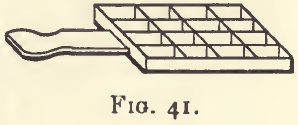CUPELLATION & Silver Assaying

The process is as follows:—The cupels, which should have been made some time before and stored in a dry place, are first cleaned by gentle rubbing with the finger and blowing off the loose dust; and then placed in a hot muffle and heated to redness for from 5 to 10 minutes before the alloy […]
Assaying Lead Determination Method Pb

The chief ore of lead is galena, a sulphide of lead, common in most mining districts, and frequently associated with blende and copper-pyrites. It always carries more or less silver; so that in the assay of the ore a silver determination is always necessary. Carbonate (cerussite), sulphate (anglesite), and phosphate (pyromorphite) of lead also occur […]
Assaying Antimony Determination Method
Antimony occurs in the native state, but is rare; its common ore is antimonite, the sulphide (Sb2S8). Jamesonite and other sulphides of lead and antimony are frequently met with. Sulphide of antimony is also a constituent of fahlerz and of many silver ores. Antimonite occurs generally in fibrous masses, has a lead-like metallic lustre, is […]
Assaying Bismuth Determination Method

Bismuth is nearly always found in nature in the metallic state; but occasionally it is met with as sulphide in bismuthine and as carbonate in bismutite. It is also found in some comparatively rare minerals, such as tetradymite, combined with tellurium, and associated with gold. In minute quantities it is widely distributed: it is a […]
Assaying Thallium Determination Method
Thallium is a rare metal, found in small quantities in some varieties of iron and copper pyrites, and in some lithia micas. It resembles lead in appearance. Its compounds resemble the salts of the alkalies in some respects; and, in others, those of the heavy metals. It is detected by the green colour which its […]
Assaying Cadmium Determination Methods
Cadmium occurs in nature as cadmium sulphide in greenockite, CdS, which is very rare. It is widely diffused in calamine, blende, and other zinc ores, forming, in some cases, as much as 2 or 3 per cent, of the ore. Oxide of cadmium forms the “ brown blaze ” of the zinc smelters. Sulphide of […]
Assaying Zinc Determination Methods
Zinc occurs in nature most commonly as sulphide (blende); it also occurs as carbonate (calamine) and silicate (smithsonite). Each of these is sufficiently abundant to be a source of the metal. The metal is known in commerce as “ spelter ” when in ingots, and as sheet zinc when rolled. It is chiefly used in […]
Assaying Cobalt Determination Methods
Occurs less abundantly than nickel. Its chief ores are smaltite and cobaltite, which are arsenides of cobalt, with more or less iron, nickel, and copper. It also occurs as arseniate in erythrine, and as oxide in asbolan or earthy cobalt, which is essentially a wad carrying cobalt. It is mainly used in the manufacture of […]
Assays for Titanium

Titanium only occurs as a mineral in its oxidised state, or as titanic oxide (TiO2). It is a substance which has little commercial value, and is generally recognised as one of the rare bodies; although, in small quantities, it is widely disseminated. It occurs in granite, basalt, and other igneous rocks in quantities up to […]
Tungsten Assaying

The ammonic carbonate filtrate from the silica is evaporated to dryness, ignited strongly over the blowpipe, and weighed. The residue is tungstic acid, WO3. The tungsten may be conveniently reported in this form, although it is probably present as a lower oxide. The acid filtrate from the silica and tungstic acid is treated with sulphuretted […]
